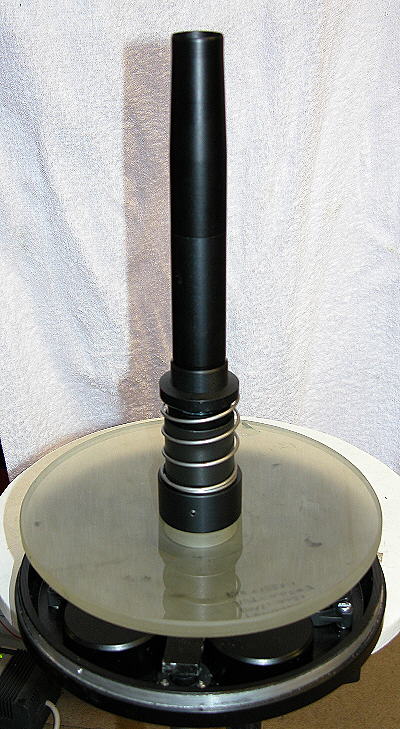8-inch Rumak Maksutov
The Bolton Group
8-inch Rumak MaksutovThe Bolton Group
|
Optics: note small secondary only 44mm in diameter this represents only 22% for Apo/refractor like performance.
|
Introduction
Our 8-inch Ritchey-Chretien (R-C) might be a great deep-sky imaging instrument but visually that large central obstruction degrades the view. For better visual performance the answer is a Rumak/Maksutov. If it were to have a high focal ratio then the central obstruction could be reduced to an insignificant size. It would behave as a colour free 8-inch Apo in a tube half the length. Initially it was decided to follow the design in Rutten and van Venrooj's book for a f/15 Rumak/Mak. However, following a visit to Orion Optics and discussions with Barry Pemberton the design was switched to that of the OMC200 ie an f/20 Rumak.
|
 Central baffle is a very precise profile and was purchased from Orion Optics
|
Optical Tube
The Rumak/Maksutov design features a separate secondary rather than a silvered spot on the rear of the corrector as in the more common Gregory Maksutov. The extra degree of freedom that this provides over the Gregory Maksutov results in a far better design and stunning performance across the whole field. The downside is that a separate secondary mirror has to be made but the result is well worth the effort. The OMC200 design was freely given by Barry but its parameters cannot be disclosed. It is a Rutten and van Venrooj special design. It features a very small secondary mirror (22% obstruction) and is optimised for planetary use.The f/20 ratio gives a focal length of 4 metres. Imaging with a webcam only needs a slight magnification to produce excellent results. The Optics were produced by Brian but were made at Orion Optics works in Crewe. He spent several days at Crewe before they were finished to his perfection. Working there had several advantages as the specific test facuilities for this design were obviously available. The optics were finally tested independently by John Pemberton and are pretty near perfect! They were coated by Barry using the his Hilux process. The corrector was anti-reflection coated. One big advantage of following Barry's design is that the OMC components could be used. This is particularly advantageous for the central baffle which is a precise design. Focusing is by primary mirror movement. In Schmidt-Cassegrains this is a weak spot resulting in the dreaded image shift. To overcome this, small ball bearings were used, one either side of the bearing point under the flange that holds the mirror - this eliminates any lateral thrust that would cause image shift. This tweak is not in the Orion Optics commercial version. The tube was also purchased from Orion Optics. It features twin fans for cooling the optics.Weight is just under 10Kg. A later development was the addition of a dc controlled electric focuser. This fits over the focusing knob and makes remote focusing for imaging straight forward. |
The removeable electric focuser is visible in this side view. A custom made quality case for safe keeping of the scope has been made by Gerald. |